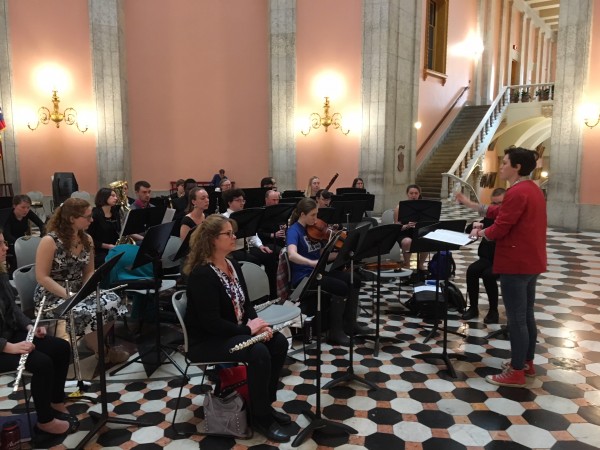Music as Protest: “An American Elegy” at the Statehouse

This past Saturday, over a dozen members of Kenyon’s Symphonic Wind Ensemble, several Kenyon professors and community members, and a handful of students and faculty from Marietta College and Muskingum University towed our instruments and stands to the Ohio Statehouse in Columbus. We weren’t giving a performance in the traditional sense. We were staging a protest.
In the wake of the Parkland, Florida, school shooting in February, my classmate Leah Dunbar ’20 began organizing a musical protest, emailing fellow music students to gauge interest. For the protest, we would play renowned concert band composer Frank Ticheli’s “An American Elegy,” a 10-minute piece dedicated to the students of Columbine High School. But we wouldn’t play the piece once — rather, we would play it 27 times, once for each of the 26 school shootings that have occurred since Columbine, with the 27th performance having no dedication, in the hope that it would never need to.
We weren’t the only Kenyon students to protest gun violence this semester. Many students participated in the March For Our Lives last month in Washington, D.C., and a walkout is planned on campus for 10:10 a.m. this Friday as part of a nationwide event.
After getting to the Statehouse at 10 a.m. on Saturday, we set up our stands and chairs, preparing for many hours of performance. Schedules were passed out detailing who took breaks when and which conductor was up next. We were playing right underneath the dome of the building, creating an acoustic I’d never heard before. After we finished playing the piece for the first time, the echo of the strings’ final notes lingered in the air for several seconds. Then everyone took a breath, adjusted their music, and got ready to start again.
Before every performance of the piece, a short dedication was read. They were basic — only detailing the name of the affected school, the date of the shooting, and the number of dead or wounded — but effective, sombering. I had helped write a few of them in the week before the protest, and I was surprised by how many events I simply hadn’t heard of, the shootings with little to no media coverage because the body count didn’t rise above one or two. But we played “An American Elegy” for each of the schools. It felt like nowhere near enough, an act of remembrance impossibly small when compared to the enormity of the violent acts that took place at each of these schools.
Although the building’s government offices were closed on the weekend, small groups of visitors stumbled upon our performance throughout the day. Many took photos or videos with their phones. Some moved on quickly, but most stopped for the full 10 minutes of the piece and read the fliers Leah had printed out to explain our protest. The hall was never crowded, but it was never empty, either.
There were two professional conductors with us: Professor Heuchemer, or “H,” director of Kenyon’s Symphonic Wind Ensemble, and Professor Turrill from Muskingum. They conducted the first six renditions of the song, and then student conductors began to take the stand. Leah and I, as well as fellow music student Ethan, are all taking Doc Locke’s conducting course this semester, so we all volunteered to conduct as well.
I’d never conducted more than a two- or three-minute piece before, so conducting “An American Elegy” was daunting, especially in a setting where it felt important to get it right. But I followed the changing meters with my hands well enough, and our small band of musicians knew the piece almost by heart by the time I took the stand at the ninth rendition. We got through it. Then, after three more renditions, I took the stand again, this time conducting the piece twice in a row. After the final phrase of the piece, before lowering my hands, I looked at the group, our last note still hovering in the upper chambers of the rotunda above us.
There is still so much work to be done about gun violence in this country. Many more protests and legislative battles await. But just then, in the charged air that lies between the end of a piece of music and the beginning of quiet, I felt a moment of connection. It still wasn’t enough. But it was comforting to remember that, in wake of so much senseless violence, those moments exist too.
